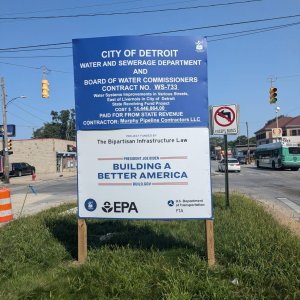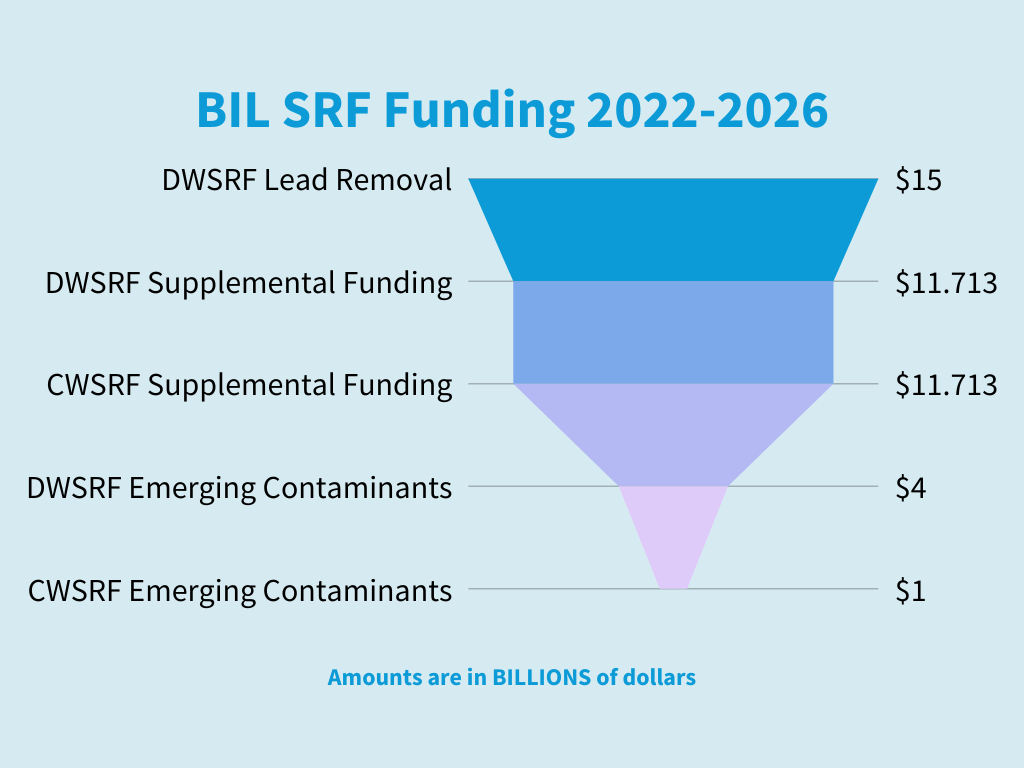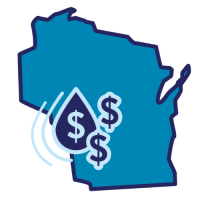State Action on Improving State Revolving Fund Programs
What’s the Issue?
The Clean Water and Drinking Water State Revolving Funds (CWSRF and DWSRFs) represent the largest source of federal funding for water infrastructure. These funds are intended to support communities across the country by increasing their financial capacity to take on large water infrastructure projects. These projects can address many issues: outdated and leaking pipes, increasing the storage capacity of water treatment plants, or ensuring continuous delivery of safe and clean drinking water to residents.
In practice, however, the communities most in need of investment in their water infrastructure regularly face barriers to accessing these dollars. While the SRFs are meant to support communities nationwide in addressing the most critical issues of water quality and access, the process has remained inaccessible to communities in need due to a range of systemic issues. Some of these issues include burdensome funding and financial capacity requirements for states and municipalities, lengthy and bureaucratic application processes, and a lack of transparency and opportunity for engagement in the process.
The Bipartisan Infrastructure Law (BIL, also called the Infrastructure Investment and Jobs Act, or IIJA), passed in 2021, drastically increased the amount of funding for the SRF programs. Between 2022 and 2026, Clean Water and Drinking Water State Revolving Funds will provide states, tribes, and territories with increased levels of funding to tackle pressing infrastructure needs.
Clean Water for All: Getting the Money to Communities Who Need It Most
Historically, larger drinking water systems serving majority-white populations have been more successful in their bids for SRF funding. Small communities and communities with larger proportions of people of color have been less likely to receive financial assistance when they do apply and oftentimes do not apply for SRF funds due to both financial and non-financial capacity and process constraints. The legacy of redlining, racial segregation, and discriminatory lending practices are evident today in the maintenance needs of water infrastructure in low-wealth communities that struggle to adequately finance projects and secure needed technical expertise. Aging infrastructure increases a community’s likelihood of experiencing lower water quality, less efficient systems, and threats ranging from contamination to exacerbated flooding or water scarcity.
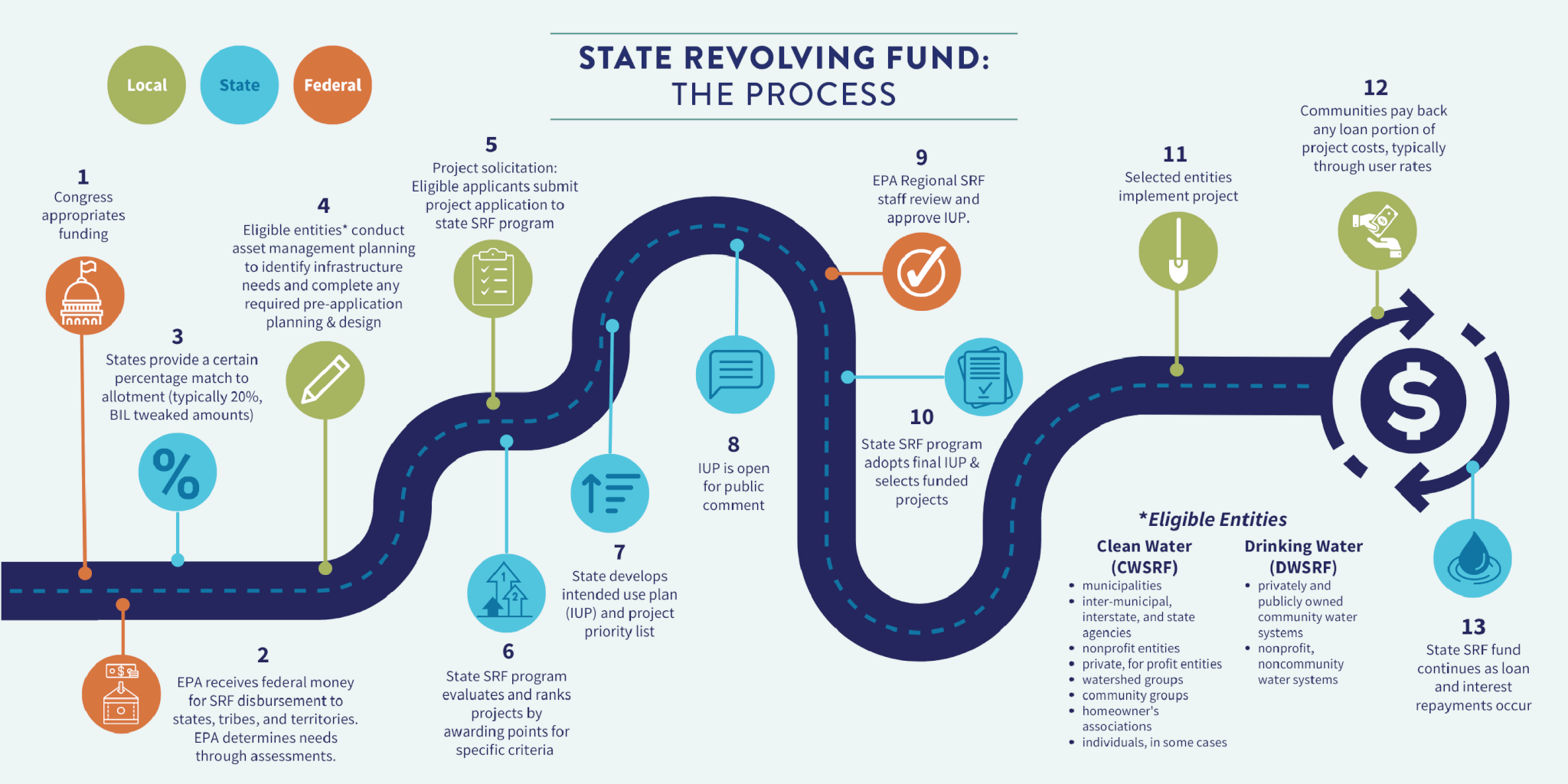
The Role of States
Upon passage of the Bipartisan Infrastructure Law, the US Environmental Protection Agency (EPA) issued updated guidance to states and tribes outlining implementation requirements and recommendations. Because of the way the SRF programs are designed, states have a lot of authority and discretion on how to operate their respective programs.
The SRF policies featured in the State Policy Hub highlight state-level approaches and successes that create more fair distribution of SRF funding. Some of these examples pre-date BIL, while others are very recent changes.
Currently, we’re focusing on showcasing the following policy details in the Hub:
- Examples of state policies that create transparent procedural practices that prioritize public participation and community input and strive to create access to information regarding SRF timelines, documentation, and technical assistance opportunities.
- For a country-wide snapshot of how accessible and transparent state SRF programs are, see Clean Water Action’s 2023 report: Equitable and Effective Water Infrastructure Spending: Increasing Transparency and Accessibility in State Revolving Fund Programs.
- Examples of states with strong definitions of “disadvantaged communities” (DACs) for the DWSRF and/or with strong definitions of “affordability criteria” for the CWSRF, along with how states weigh these factors in project scoring criteria, to ensure funds go to communities with greatest need.
- Examples of state policies that are prioritizing climate resilience, green infrastructure, non-point source pollution reduction, and nature-based projects through program goals, project ranking, eligibility criteria, and innovative funding mechanisms.
How Are We Defining “Policies”?
In other sections of the State Policy Hub and in the policy database, we typically feature state laws, along with some regulations, Executive Orders, and constitutional amendments. State agencies that administer the SRF programs abide by federal law (the Clean Water Act and Safe Drinking Water Act) and state law requirements but also develop programmatic policies through Intended Use Plans (IUPs). The Hub includes IUPs, in addition to state laws and regulations, since they house the most pertinent information on how states intend to spend their water infrastructure funding.
Each state creates an annual IUP describing the state’s:
- programmatic goals,
- the process for ranking projects applications for selection and accompanying Project Priority List (PPL),
- how set-aside funding will be used,
- how they have defined and prioritized disadvantaged communities (DACs) (for DWSRF) and affordability criteria (for CWSRF),
- a description of public review and comment, and
- criteria and methods for distributing funds.
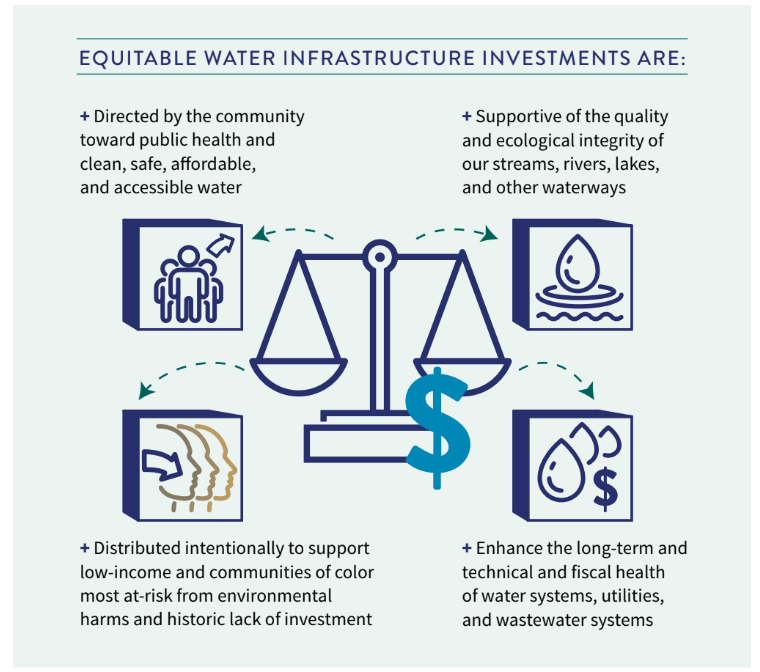
River Network’s definition of equitable water infrastructure investment informed how we selected policies to feature in the State Policy Hub.
Examples of State Policy
- Wisconsin: Wisconsin’s Disadvantaged Community definition and project scoring criteria: In Wisconsin, the Drinking Water SRF program is referred to as a Safe Drinking Water Loan Program (SDWLP). Wisconsin SDWLP uses a ranked allocation methodology for principal forgiveness to give projects with the greatest financial need the best possible loan terms.
- Ohio: Ohio’s Clean Water SRF program includes distinct sub-programs that direct funding towards restoration, non-point source pollution reduction, and nature-based solutions. Find the most recent programmatic policies in the state’s Program Management Plan.
Lessons from the Network

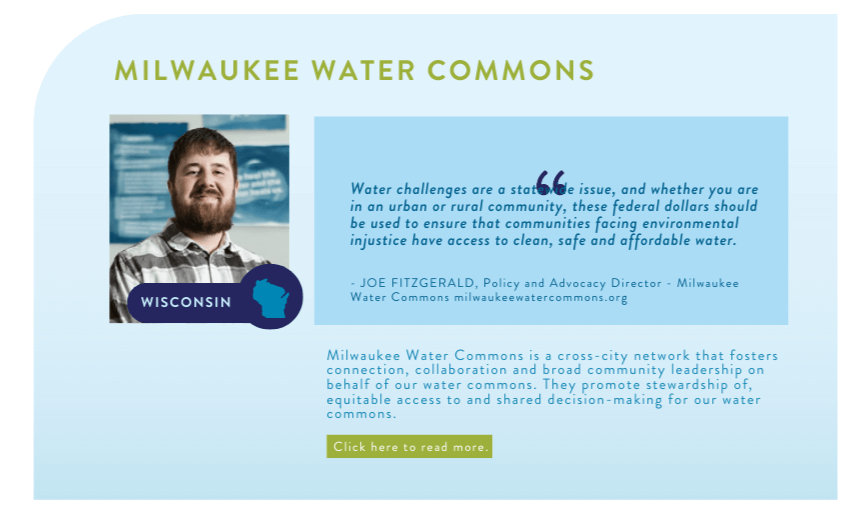 Additional Resources
Additional Resources
- SRF State Advocates Forum
- River Network’s Self-paced SRF advocacy training series
- River Network’s SRF Advocacy Toolkit (2022)
- River Network’s State Agencies and EPA Regional Offices: Helpful Links and Contacts
- US Water Alliance’s How States Can Lead on Water: The Critical Role of Innovative Funding and Public Awareness (2025)
- Natural Resources Defense Council’s report: Will Funds Flow Fairly? State Water Infrastructure Equity Report Cards (2024)
- PolicyLink’s Southern State Revolving Fund Analysis and Advocacy Project (ongoing)
- Lawyers for Good Government: A 50-State Survey of State Policies to Help Ensure Federal Investments Benefit “Disadvantaged Communities” Under Biden’s Justice40 Initiative, (2022/2023)
- Association of State Drinking Water Administrators (ASDWA), A New Era for the Drinking Water State Revolving Funds: Identifying Ways to Better Assist Disadvantaged Communities (January 2023)
- Brookings Institute’s report: Exploring and Improving How State Water Funding Flows Amid a Surge in Federal Infrastructure Investment (December 2024).
- Clean Water Action’s report Equitable and Effective Water Infrastructure Spending: Increasing Transparency and Accessibility in State Revolving Fund Programs (2023)
- US EPA Resources:
- US Environmental Protection Agency’s Clean Water SRF website
- US Environmental Protection Agency’s Drinking Water SRF website
- EPA SRF data dashboards, public portals, and project map
- Armendariz, K. Who Benefits From The Funding? Evaluating Procedural Justice In Meeting Justice40 And Bil Requirements In The Wisconsin Clean Water State Revolving Fund Program (2024)
- Environmental Policy Innovation Center (EPIC) policy briefs and reports, including:
- Increasing State Revolving Fund Capacity through Leveraging (2021)
- Are More Drinking Water Funds Going to State-defined Disadvantaged Communities through State Revolving Funds? (Answer: Be Patient!) (2024)
SRF Policy Database
| Name | State | Action Agency | Policy Focus | Description |
|---|---|---|---|---|
| Wisconsin Safe Drinking Water Loan Program | Wisconsin | Wisconsin Department of Natural Resources | The Clean Water Fund Program (CWFP) and Safe Drinking Water Loan Program (SDWLP) implementation details are established in the governing statutes and administrative codes: ss. 281.58, 281.59, and 281.61, Wis. Stats., and chs. NR 162 and 166, Wis. Adm. Code, and the Wisconsin Department of Natural Resources also makes programmatic changes through Intended Use Plans. Wisconsin's disadvantaged community (DAC) definition and scoring system is fairly holistic. The state uses multiple criteria in the DAC definition and ranks and awards principal forgiveness according to severity of need. |
|
| Senate Joint Resolution 95-19 (Colorado Drinking Water Revolving Fund) | Colorado | Colorado Water Resources and Power Development Authority, Colorado Department of Public Health and Environment, and Colorado Department of Local Affairs, Division of Local Government | Colorado's Drinking Water Revolving Fund priority scoring model considers several factors in scoring affordability points, which informs how projects are ranked and awarded additional subsidization (i.e., principal forgiveness). Find further detail in the Intended Use Plan (IUP): https://cdphe.colorado.gov/state-revolving-fund-information and this Defining Disadvantaged Communities: Providing Resources for Drinking Water and Wastewater Infrastructure Projects, State Revolving Fund (published 2023) https://www.cwrpda.com/_files/ugd/f1310e_40a84262f54343058338c632e21aab67.pdf |
|
| Ohio Water Pollution Control Loan Fund (state code and program management plan) | Ohio | Ohio Environmental Protection Agency Office of Financial Assistance and Ohio Water Development Authority | Ohio's Water Pollution Control Fund has several programs established to address nonpoint source pollution and ecological integrity. |


